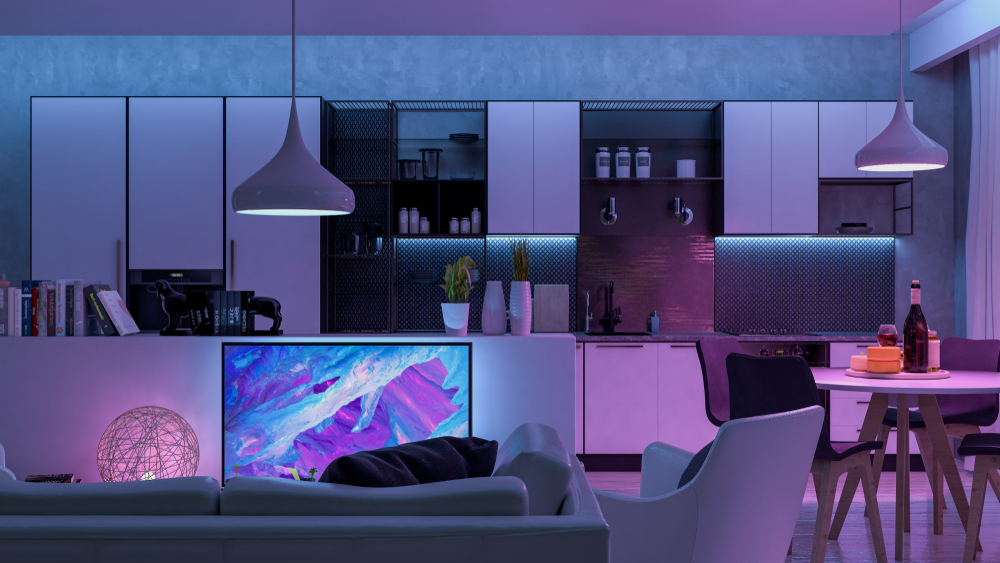With their excellent energy efficiency, affordable price tags, and numerous customized options, LED light bulbs are quickly becoming the top choice for home lighting. Available in small bulbs and flexible strips, these microchip-powered wonders fill almost every need in your home– including some you didn’t even know you had!
So get ready to upgrade your home’s functionality and style! Here are nine ways using LED bulbs in your home can improve your home’s design, costs, comfort, and safety.
1. Energy Efficient

LEDs are highly energy-efficient light sources because they create light with a microchip. With no gas or burning filament, they waste far less energy in heat production (not to mention much better customization in color, brightness, and temperature. But we’ll get to that later!)
Unlike older bulbs, LED bulb packaging uses lumens instead of watts to tell you how bright they are. Watts measured the electricity needed for incandescent bulbs to glow, but lumens directly measure the amount of light a bulb gives off. The higher the lumens, the brighter the bulb.
But it’s not just the packaging that’s changed– your utility bill will decrease when you replace incandescent bulbs with LEDs. They use far less energy than incandescent bulbs to give off the same level of light, savings you’ll actually be able to see.
2. Work with Most Light Fixtures

No matter your light fixture, there’s likely an LED bulb that’s a perfect match. LEDs come in a wide variety of standard-sized bulb sizes and shapes– so you can even use them in your candelabra chandelier!
The only thing to watch out for is ventilation. LEDs are cool bulbs compared to incandescent and other traditional options, but they’re not entirely immune to overheating. So if you’re ever in doubt, give a local lighting expert a call and they’ll help you find the correct bulb.
3. Safer than Other Bulbs

LED bulbs are one of the safest ways to light your home– they produce minimal heat and use very little energy. They’re even safer than fluorescent bulbs, a top competitor for energy-saving lighting. Compact fluorescent bulbs, or CFLs, glow by passing an electrical current through mercury gas. So CFLs are a little risky in “accident-prone homes,” like homes with pets or small children.
On the other hand, LEDs glow using a microchip. In fact, LEDs don’t even need to use the glass bulb case– they’d be just as safe and contained without it! So if you want to increase your home safety while still being energy efficient, swap out your CFLs for LEDs.
4. Best Color Rendering Index (CRI)

Did you know that the way you see color depends heavily on the type of light shining on it? Stores and online product photos use great lighting to show their products at their best potential. But if you bring those products home in poor lighting, you may be surprised to find that it doesn’t look as great as they did before. It’s not always buyer’s remorse, though– sometimes it’s just bad lighting!
LEDs are one of the best on the color rendering index (CRI), meaning they show colors more accurately. Their light will be very close to the lighting in-store or in the product images, so it’s much more likely to look the same in your home as it did in the cart.
As a bonus, high CRI lighting is a huge help in places like your bathroom or closet. Accurate lighting can help you pick the right clothes and do your best makeup. No more surprises when you see yourself in the office mirror!
5. Dimmable

Dimmable bulbs are perfect for rooms with multiple functions. Take your living room, for example– during the day, you’ll want bright light as you move about your daily activities and tasks. But in the evening, you want your living room to be a soft, cozy space where you can relax and unwind.
LEDs can come with dimmable capabilities, making them perfect solutions for bathrooms and bedrooms. They will also work with your existing dimmer switches and remotes. So simply swap out your old bulb, and you’re ready for a day-to-night lighting experience!
6. Vary in Temperature

A bulb’s light temperature refers to whether the light falls into cool (blue) or warm (red) light. Cool, blue light is in the same range as direct sunlight– it wakes you up and gets you focused. Warm light is similar to fire and candlelight and helps you to relax. Traditional bulbs were all warm light, but modern LEDs come in a wide variety of light temperatures.
How will knowing this improve your home, you ask? Our bodies work with a circadian rhythm– the natural cues to wake up with the sunrise and relax at sunset. But our modern life surrounds us with blue light well after sunset, eliminating the natural transition to red light before sleep. Choosing the right LED bulbs makes it easy to reintroduce the red light phase to your circadian rhythm.
Opt for warm light bulbs in places where you relax at the end of the day (dining room, living room, bedroom, etc.), and it’ll help signal to your brain that it’s time to go to bed– making it easier to fall asleep at bedtime. Just don’t undo your brain’s relaxation by staring at your phone screen in bed afterward!
7. Smart Integrations

What’s a smart home without smart lighting? LED bulbs are a top smart home choice because they offer a wide range of stress-free customization.
This flexibility makes them a great choice to use on their own, but they’re also great options to use with your smart home setup. Set routines for lights to turn on and off and control settings from your phone on the go!
You can even create a habit with your smart home assistant to ”warm up” the temperature of your LEDs a few hours before bed. It’s a simple change that could significantly help your family rest better– and avoid the increased risk of depression, anxiety, and weight gain connected to regular poor sleep.
Remember, not every LED bulb is “smart,” so make sure you read the packaging to get the perfect addition to your smart setup!
8. Customize Color

LED stands for “light emitting diode”– big words to describe a glow from passing electricity through a microchip. Because of the way they work, many LED bulbs can change color, temperature, and brightness with the press of a button.
Color customization may seem like a party trick with little functional use. And while they are a great novelty at parties, color-changing lights can also help you wind down at night and reduce eye strain when watching TV or sitting in front of a computer monitor.
LEDs are excellent for creating bias lighting for your TV or computer. Bias lighting casts light on the wall surrounding your screen to help decrease the intensity of the image, making it easier on your eyes. It also increases the contrast of your screen, so you’ll get a better view without upgrading your tech!
9. Strip Lighting

A lesser-known use for LED lights in the home is strip lights. If you’re looking to make your home look and feel like a bespoke model home, these are the way to go. The best part– they’re inexpensive and simple to install.
LED strip lights can be wired to a switch, but homeowners often opt for battery-powered or plug-in options for noninvasive installation. They typically come with either a remote or smart home integration capabilities. They’re also tiny, and since many come in a user-friendly peel-and-stick variety, they’ll fit just about anywhere!
We recommend trying out LED strip lights in places like:
- Kitchen Cabinets: Stash these inconspicuously under cabinets to make dinner prep easier and safer, or add them inside glass-fronted cabinets to turn your dishes into art! You can also place them under the toe-kick to light those late-night snack runs.
- Stairways: Make your evening bathroom trip safer by lining your stairs with light. Don’t want to see them? Try tucking them underneath the handrail!
- Closets and Shelves: Want to turn your dark closet into an elegant dressing room? LED strip lighting will elevate your closet without any structural changes. Add them to the top of shelves, above your shoes, or around the top edges of your walls – they’ll go anywhere you need more light.
- Bedroom Mood Lighting: String a few LEDs around your walls and change the color or brightness of your entire room without lifting a paintbrush– a very popular DIY for teenagers and social media creators
- Bathroom GlowUp: Stash a few LEDs under bathroom cabinets for a toe-kick touch of luxury and soft lighting. Or use around your mirrors for true lighting during your daily skincare routine!
The Possibilities are Endless

LED bulbs and strips are small, easy to install, and can fit just about anywhere. Whether you’re swapping out all of your home’s bulbs or just adding custom lighting to your favorite spaces, LEDs can give you that luxury feel without breaking the bank. And when you factor in their energy efficiency, customization applications, health benefits, and smart home applications, it’s easy to see why LED bulbs are the swiss army knife for home lighting needs.
Proper lighting is essential to a fully functioning home– but it can be challenging to nail the balance between light levels, fixture designs, and a budget! For your next project, contact the experts at The Lighting House.

